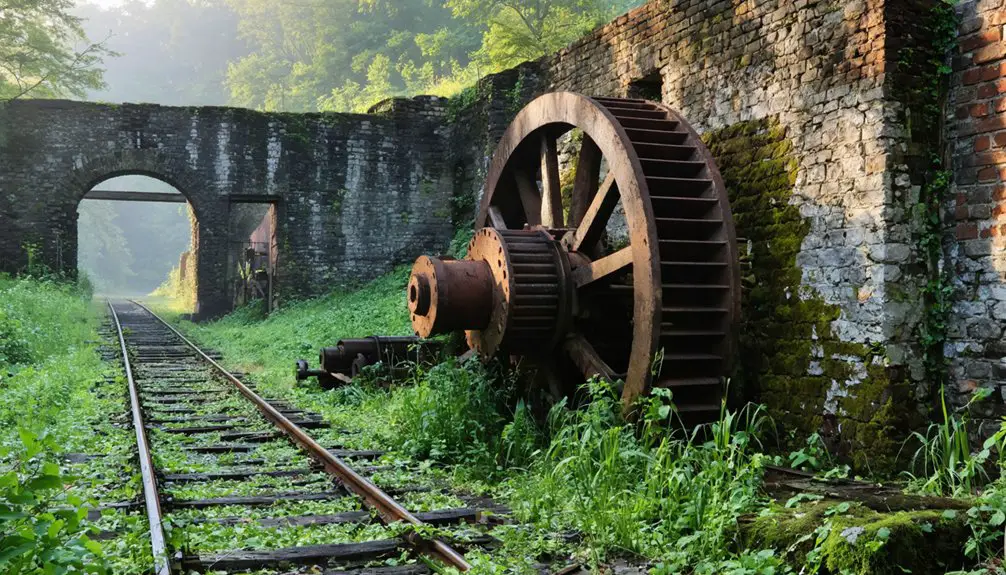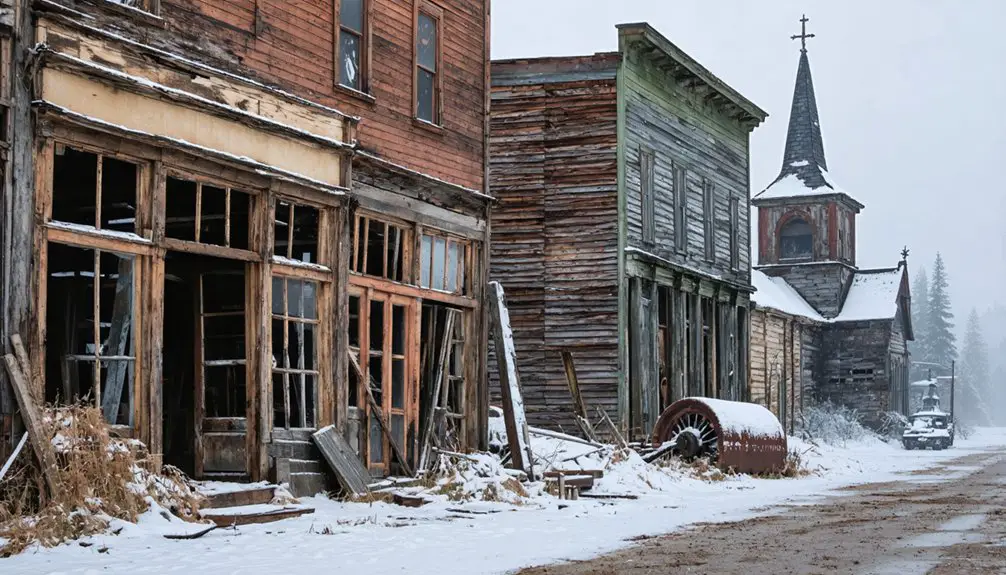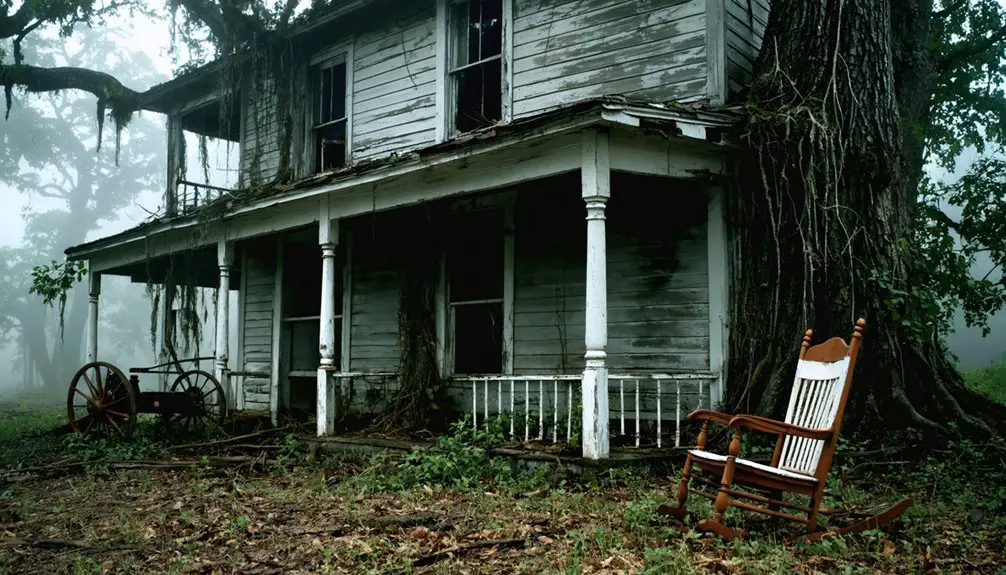You’ll discover the haunting ruins of Virginius Island, a once-thriving 19th-century industrial town at the confluence of the Shenandoah and Potomac Rivers in West Virginia. This former manufacturing hub featured flour mills, sawmills, and worker housing until devastating floods and the Civil War led to its abandonment. Today, archaeological remnants and stone foundations tell the story of hardy mill workers who endured 12-hour workdays. The island’s artifacts reveal an untold chapter of America’s industrial heritage.
Key Takeaways
- Virginius Island became a ghost town after multiple devastating floods, with the worst in 1936 forcing final abandonment of the settlement.
- Originally a thriving industrial hub powered by the Shenandoah River, the island produced up to 80,000 barrels of flour annually.
- The Civil War’s destruction and shift from water to steam power contributed significantly to the island’s eventual abandonment.
- Today, visitors can explore ruins of 28 dwellings and industrial structures as part of Harpers Ferry National Historical Park.
- Archaeological excavations reveal artifacts from the 19th-century community that balanced traditional crafts with industrial capitalism.
The Birth of an Industrial Haven (1800-1824)
While many lands near Harpers Ferry remained under federal control or Wager family ownership in the early 1800s, Virginius Island emerged as a unique industrial opportunity through strategic development.
You’ll find the industrial beginnings took shape in 1806 when the Patowmack Company constructed a 580-yard Shenandoah Canal, effectively creating the island by bypassing rapids.
Early settlers quickly recognized the potential of this 13-acre property, which changed hands from surveyor Daniel McPherson in 1816 to James Stubblefield by 1823.
Water-powered enterprises, including flour mills, sawmills, and blacksmith shops, sprouted along the riverbank, laying the foundation for a thriving industrial center.
Though these initial ventures faced challenges, they established the island’s identity as a prime location for harnessing the Shenandoah’s power for manufacturing pursuits.
Under the guidance of James Stubblefield, who served as the federal armory superintendent, the area began attracting skilled workers and entrepreneurs.
The area was officially incorporated as the Town of Virginius in 1827, marking its establishment as an independent industrial village.
Rise of the Island’s Manufacturing Empire
After Lewis Wernwag established the island’s first sawmill in 1824, Virginius Island transformed into a bustling manufacturing hub that would define the region’s industrial landscape.
The Shenandoah River’s power drove the machinery that made the island’s remarkable industrial growth possible. You’d find cotton mills, flour mills, tanneries, machine shops, and iron foundries powered by an innovative network of canals, tunnels, and turbines. Industrial innovation flourished as multi-story factories rose along the waterfront, with flour milling emerging as the dominant force producing up to 80,000 barrels annually.
Economic shifts marked the island’s trajectory when Abraham Herr acquired the entire property in 1854, managing operations through strategic leases and partnerships.
Despite setbacks during the Civil War, including the destruction of Herr’s mill by Confederate forces, the island’s industries adapted and evolved, particularly under Child and McCreight’s successful flour milling venture after 1867.
Daily Life in a 19th Century Mill Town
Though manufacturing powered Virginius Island’s economy, daily life for mill workers revolved around harsh realities of industrial labor and company control. You’d find families cramped into single-room dwellings near the mills, where worker conditions included punishing 12-hour workdays and strict oversight. Weekly wages were especially harsh for women who earned just $2.20 per week.
Children weren’t spared, facing unpaid apprenticeships and physical punishment for infractions. Similar to the workers at Windsor Power Plant, they created a tight-knit community with amenities to support each other.
Yet community life extended beyond the mill’s grip. Workers tended small gardens to supplement their meager wages, while evening hours brought moments of respite through dances and social gatherings.
Despite harsh factory life, workers found solace in small gardens, evening dances, and community gatherings, creating moments of freedom.
Company stores served as economic hubs where clerks delivered goods directly to homes. Despite the oppressive environment, mill families created pockets of freedom through traditional games, music, and seasonal celebrations in communal spaces.
Engineering Marvel: Water-Powered Infrastructure
Before industrialization transformed Virginius Island, the Patowmack Company’s visionary engineers constructed the Shenandoah Canal in 1806, creating a sophisticated water management system that would power the region’s industrial revolution.
You’ll find remarkable evidence of this engineering feat in the network of stone-lined canals and tunnels that once controlled water flow throughout the 12-acre island. Robust headgates and intake tunnels directed Shenandoah River water to multiple mills, while ingenious siltation basins prevented sediment buildup.
The system evolved from traditional water wheels to more efficient turbines, powering everything from cotton mills to iron foundries. This infrastructure marvel optimized industrial efficiency by enabling simultaneous operation of sawmills, flour mills, and machine shops, transforming a small island into a thriving manufacturing hub. The island’s location at the confluence of major rivers made it an ideal site for water-powered industry.
The Civil War’s Devastating Impact
During the American Civil War (1861-1865), Virginius Island‘s thriving industrial complex met a devastating fate. Union and Confederate forces repeatedly clashed over this strategic location, transforming the island’s mills and factories into military installations, barracks, and storage facilities.
You’ll find evidence of the war’s destruction in the remnants of the rifle factory, flour mills, and the once-mighty Harpers Ferry Armory – all casualties of bombardment and fire. The Winchester and Potomac Railroad provided crucial transport through the island during wartime operations.
The economic decline was swift and severe, with the population plummeting from 183 to 103 residents between 1850 and 1870. Workers fled the violence, while those who remained faced malnutrition, disease, and deteriorating living conditions.
The government’s decision not to rebuild the armory after the war sealed the island’s industrial fate, marking the end of its prosperous era.
Nature’s Fury: A History of Destructive Floods
You’ll discover the turning point of Virginius Island’s fate in the devastating Great Virginia Flood of 1870, which scoured the island’s surface bare and destroyed nearly every building in its path.
Poor women and children fled to rooftops as floodwaters rapidly engulfed their homes.
Though some industries attempted to rebuild, subsequent major floods in 1889 and 1936 repeatedly battered the island’s infrastructure, making recovery increasingly difficult.
The relentless cycle of flooding, combined with the shift from water to steam power, ultimately sealed the island’s transformation from industrial hub to abandoned ghost town.
Major Floods Strike Hard
While Virginius Island’s industrial potential drew entrepreneurs to harness its waterpower, the same rivers that powered its mills ultimately spelled disaster for the settlement.
The Great Virginia Flood of 1870 struck first, stripping the island’s soil and devastating nearly every building. Industrial decline followed as subsequent floods battered the remaining structures.
You’ll find evidence of nature’s raw power in the flood dynamics that shaped the island’s fate. When the Potomac backed up into the Shenandoah, it created temporary lakes that deposited thick layers of sediment.
Even more destructive were the times when the Shenandoah ran higher, sending raging waters directly across the island. The final blow came in 1936 with the worst recorded flood, forcing the last inhabitants to abandon their homes forever.
Recovery Attempts Fall Short
Despite valiant efforts to rebuild after each catastrophic flood, Virginius Island’s industrial recovery faced insurmountable challenges beyond nature’s fury.
You’ll find that economic constraints crippled community resilience, as steam-powered factories elsewhere gained competitive advantages over water-dependent mills.
The island’s industries struggled against mounting odds: recurring floods in 1870 and 1889 destroyed buildings and scoured the landscape, while technological shifts favored coal and steam power over traditional water wheels. The final devastating flood of 1936 forced the complete abandonment of industrial operations on the island.
The National Park Service’s archaeological studies reveal a working community plagued by poor nutrition and health conditions, highlighting the harsh realities of industrial life.
Abandonment Seals Island’s Fate
Three distinct flood patterns sealed Virginius Island’s fate, with devastating impacts that ultimately forced its abandonment. The island’s attempts at flood mitigation proved futile against nature’s relentless assault, leading to industrial decline and eventual desertion.
- When the Potomac backed into the Shenandoah, it created a lake that smothered the island under two feet of sediment.
- Violent Shenandoah surges destroyed structures and eroded the landscape.
- Combined flooding events continuously reshaped the island’s geography and infrastructure.
You’ll find evidence of this destruction in archaeological digs, where pre-1870 soil layers are virtually nonexistent.
While the cotton mill briefly survived the 1870 catastrophe, subsequent floods in 1889 and 1936 accelerated the exodus.
Competition from coal and steam power sealed the deal, making rebuilding efforts economically unfeasible.
Archaeological Discoveries and Human Stories
As archaeologists excavated Virginius Island through small-scale units and shovel test pits, they uncovered thousands of 19th-century artifacts that paint a vivid picture of industrial and domestic life.
The archaeological artifacts reveal a bustling community where families balanced traditional crafts with emerging industrial capitalism. You’ll find remnants of water-powered machinery, grinding stones, and transportation infrastructure that powered the island’s diverse industries. The National Park Service conducted extensive research of the area from the 1950s through the mid-1990s.
The community dynamics emerge through household assemblages showing how residents participated in modern consumerism. You can trace social distinctions through dining artifacts and personal items.
The evidence suggests a complex society where manual laborers worked alongside entrepreneurs. Flood damage layers within the archaeological record mark the devastating 1852 and 1870 floods that ultimately contributed to the island’s abandonment.
Preservation Efforts and Modern Challenges
Since becoming part of Harpers Ferry National Historical Park in 1955, Virginius Island’s preservation has faced complex environmental and structural challenges.
You’ll find preservation techniques focused on stabilizing ruins while battling nature’s constant reclamation efforts. The island’s location at the confluence of two rivers creates ongoing threats from flooding and erosion, while vegetation growth threatens to obscure its historical remnants.
Key preservation priorities include:
- Consolidating masonry and protecting water-powered mill ruins
- Managing vegetation to prevent root damage while maintaining historic character
- Conducting archaeological excavations to identify features needing targeted conservation
The National Park Service manages these challenges through a Cultural Landscape Report that guides resource management, emphasizing conservation of industrial remnants while preserving the site’s archaeological integrity.
Walking Through History: What Remains Today
Today’s visitors to Virginius Island encounter a compelling industrial landscape where ruins of mills, foundries, and workers’ homes stand as silent witnesses to 19th-century American manufacturing.
Rusting machinery and crumbling stone walls tell haunting tales of America’s industrial past on historic Virginius Island.
You’ll discover the foundations of 28 dwellings and multiple industrial remnants scattered across the terrain, each telling stories of the island’s working-class community. Historical markers guide you through the remnants of water-powered machinery, multi-story factories, and the strategic canal system that once fueled this industrial hub.
While nature has reclaimed much of the island, you can still trace the outline of this once-bustling village through stabilized ruins and archaeological sites.
The walking trails offer intimate access to these preserved structures, allowing you to step directly into America’s industrial heritage along the Shenandoah River.
Frequently Asked Questions
Were There Any Reported Ghost Sightings or Supernatural Occurrences on Virginius Island?
Like shadows dancing through time, you’ll discover numerous ghostly encounters documented by paranormal investigations, including shadow figures, mysterious orbs, and unexplained sounds near historic buildings and abandoned industrial sites.
What Happened to the Displaced Residents After the Final 1936 Flood?
You’ll find displaced families sought shelter in public buildings and nearby towns, while others moved in with relatives. The community relocation spread residents across West Virginia and Maryland permanently.
Did Any Famous Historical Figures Visit or Conduct Business on Virginius Island?
You’d be amazed by the historical visitors who conducted business here, from George Washington’s initial vision to James Stubblefield’s armory oversight and John Brown’s nearby raid impacting local industrial operations.
What Was the Island’s Population at Its Peak Industrial Period?
You’ll find peak industrial growth brought the population to around 180-183 residents by 1850, when population dynamics were at their height, with workers filling 20-28 houses across the developed landscape.
Were There Any Successful Escape Attempts by Enslaved Workers From Virginius Island?
Like footprints in shifting sands, you’ll find historical accounts of escape methods are scarce. While waterways and mountain paths offered potential routes, there’s no confirmed documentation of successful escapes.
References
- https://theclio.com/entry/38471
- https://www.wvencyclopedia.org/entries/840
- https://en.wikipedia.org/wiki/Virginius_Island
- https://www.onlyinyourstate.com/nature/west-virginia/abandoned-town-virginius-island-hike-wv
- https://www.nps.gov/articles/000/virginius-island-600005.htm
- https://theclio.com/entry/138453
- https://npshistory.com/publications/hafe/virginius-island.pdf
- https://www.loc.gov/item/wv0536/
- http://benedante.blogspot.com/2022/12/virginius-island.html
- https://www.killinglyhistorical.org/museum/village-vignettes/life-in-a-19th-century-mill-town



